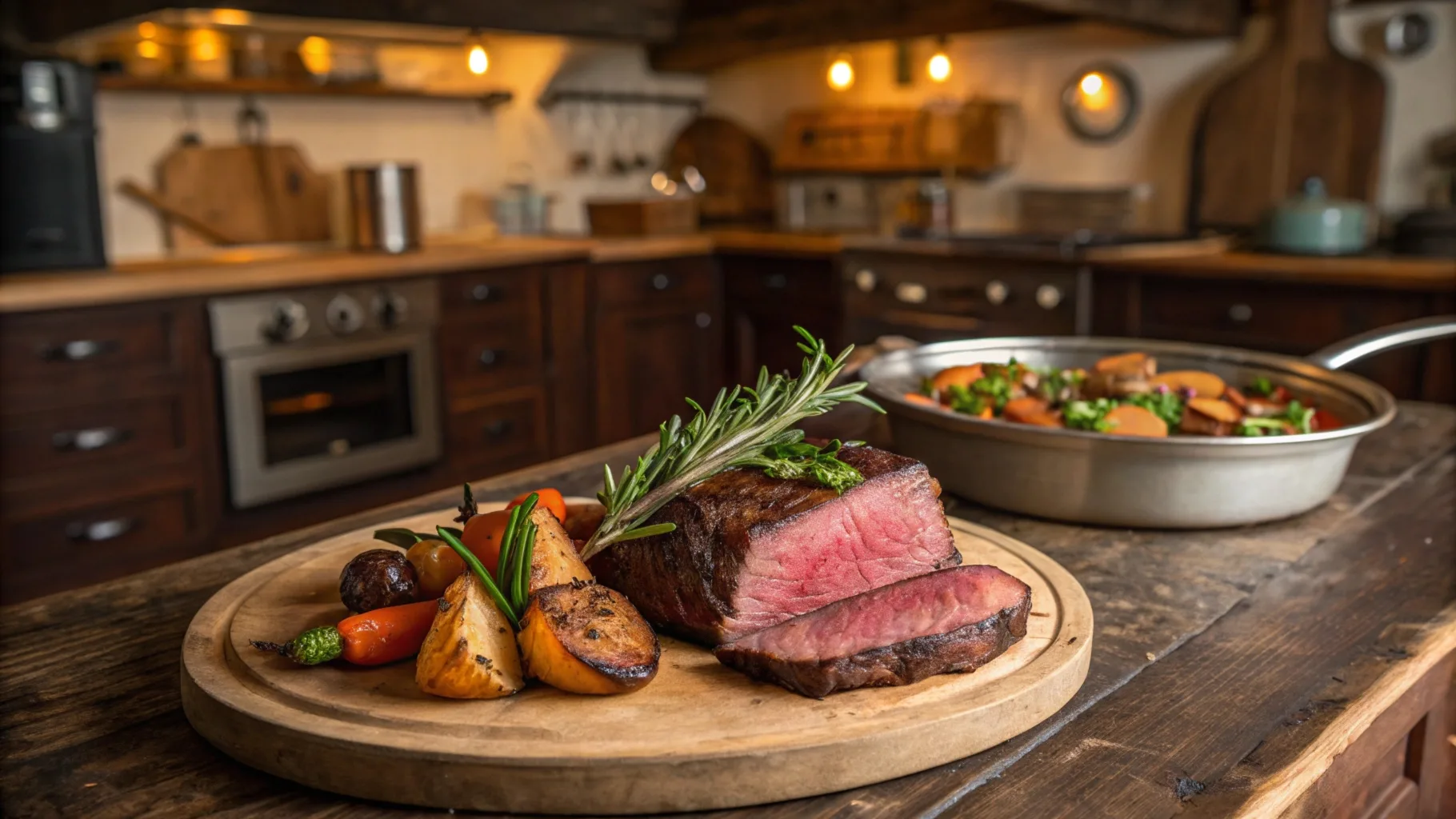Table of contents
Venison, with its rich and earthy flavor, is a prized ingredient for hunters and food enthusiasts alike. But how do you cook venison so it’s tender? Unlike beef or pork, venison is leaner and has less fat, which makes it more challenging to prepare. Without the right techniques, it’s easy to overcook and end up with a tough, dry dish.
This guide dives deep into the art of cooking venison tenderly, addressing every step from preparation to choosing the best cooking methods for different cuts. Whether you’re slow-cooking a shank, grilling tenderloin, or tenderizing a shoulder steak, you’ll discover practical tips to transform your venison into a mouthwatering masterpiece.
Understanding Venison Toughness
Tenderizing venison begins with understanding what makes it tough in the first place. Various factors—some within your control, others not—affect the texture of this game meat.
What Makes Venison Tough?
Several factors contribute to the toughness of venison, many of which relate to the deer’s life and environment. The age of the deer plays a crucial role—older animals typically have tougher meat due to more developed connective tissues. Similarly, the deer’s activity level impacts muscle texture; animals that roam vast areas and forage actively have firmer muscles. Even the deer’s diet and habitat can influence the flavor and tenderness of the meat.
While these natural factors can’t be controlled, being aware of them helps set realistic expectations. Venison isn’t beef—it requires specific handling and preparation to bring out its best qualities.
How to Control Meat Toughness Post-Hunt
While you can’t control the deer’s lifestyle, what you do after the hunt is pivotal in achieving tender venison. Start with proper field-dressing practices. Cooling the meat quickly is critical—bacteria thrive between 40°F and 140°F, so minimizing exposure to this temperature range helps prevent spoilage.
Avoid rinsing the carcass with water from creeks or ponds, as this can introduce bacteria. Instead, use a damp cloth to clean the meat if needed, ensuring it dries thoroughly with adequate airflow. By handling the meat with care during this initial stage, you’ll set the foundation for tender, flavorful venison.
Ready to dive deeper? In Part 2, we’ll explore how aging and butchering techniques impact tenderness and how these steps prepare venison for cooking perfection.
Preparing Venison for Cooking
When it comes to achieving tender venison, preparation is everything. From proper field-dressing to understanding how aging enhances texture, these steps are crucial in answering the question, “How do you cook venison so it’s tender?” Let’s delve into these essential techniques.
Field Dressing and Butchering Basics
Field dressing is the first step in preserving the quality of your venison. After the hunt, it’s essential to act quickly to cool the meat. Opening the body cavity and removing the organs immediately prevents spoilage by reducing the risk of bacterial growth. Remember, venison stored at unsafe temperatures (between 40°F and 140°F) can quickly lose its quality.
Butchering also plays a vital role in tenderness. One common mistake is cutting meat too soon after the kill, especially before rigor mortis has resolved. Rigor mortis tightens the muscles, and if these cuts are made prematurely, they remain contracted, resulting in tougher meat. Allowing time for these muscles to relax ensures a more tender end product.
Aging Venison for Maximum Tenderness
Many cooks swear by aging venison to enhance its tenderness. Aging allows natural enzymes to break down connective tissues, making the meat softer and more flavorful. The ideal temperature range for aging is between 34°F and 37°F, which slows bacterial growth while encouraging enzymatic activity.
The length of aging depends on personal preference and conditions. While 3-7 days is standard for most hunters, some prefer aging for up to 21 days for maximum tenderness. However, longer aging can result in more weight loss due to dehydration, so striking a balance is key. Aging venison properly answers the all-important question: “How do you cook venison so it’s tender?”
Tenderizing Techniques for Venison
Even with proper preparation, some cuts of venison need extra help to become tender. Whether using mechanical methods, marinades, or slow cooking, each approach has its place in your culinary toolkit.
Mechanical Tenderization
Using a mechanical tenderizer is one of the quickest ways to soften tougher cuts. Tools like meat mallets or cubers break down muscle fibers by force, making the meat easier to chew. If you’re processing venison at home, consider investing in a crank-style cuber for consistent results. For those who use a professional butcher, asking for cubed steaks is an easy way to save time.
Mechanical tenderization is especially effective for tougher cuts like round steaks and shoulder chops. This method ensures even the less tender parts of the deer can be enjoyed with minimal effort.
Marinating Tips and Tricks
Marinating venison is a classic technique for tenderizing and adding flavor. However, not all marinades are created equal. Acid-based marinades, such as those using vinegar or citrus, can sometimes make meat tougher by causing proteins to contract. Instead, opt for enzyme-based marinades (like pineapple or papaya), which break down collagen and muscle fibers without toughening the surface.
Keep in mind that marinades don’t penetrate deeply. A three-day marinade will only affect the outer layer of the meat, so use them more for flavor enhancement than tenderness.
Slow Cooking for Tough Cuts
When it comes to tough cuts like shanks or neck roasts, slow cooking is king. Techniques like braising, which involve cooking meat in liquid over low heat for hours, are ideal for breaking down connective tissues. Slow cookers and Dutch ovens work wonders, especially when paired with a flavorful broth or stock.
Braising not only tenderizes the meat but also infuses it with rich flavors. Whether you’re making a hearty stew or a barbacoa-style roast, slow cooking guarantees results that melt in your mouth.
In Part 4, we’ll explore the best ways to cook tender cuts and tackle tougher ones in the kitchen, ensuring your venison is always prepared to perfection!
Cooking Methods for Tender Venison
The way you cook venison can make or break its texture and flavor. Understanding how to handle both tender and tough cuts ensures that every meal is a success. Let’s dive into the best cooking methods to answer the popular question: “How do you cook venison so it’s tender?”
Cooking Tender Cuts
For cuts like tenderloin and backstraps, quick, high-heat methods work best. Grilling or pan-frying over medium-high heat locks in moisture and flavor. To keep tender cuts juicy, avoid cooking them beyond medium. Medium-rare is ideal and ensures that the natural tenderness of venison shines.
Season these premium cuts simply, letting their flavor shine. A dash of salt, pepper, and fresh herbs works wonders. Pair these with a light sauce or compound butter for a restaurant-quality dish.
Preparing Tough Cuts
Tougher cuts, like shanks and neck roasts, benefit from slow cooking techniques. Braising—a method of cooking meat in liquid over low heat—is a favorite. Use a Dutch oven or slow cooker, and choose flavorful liquids like broth, wine, or even tomato sauce. The long, slow process breaks down collagen, resulting in fork-tender meat that’s perfect for stews and hearty roasts.
Looking for a venison roast recipe? Check out the venison roast recipe on EatyRecipes for step-by-step guidance.
FAQs: People Also Ask
Addressing common questions about venison preparation is key to mastering this meat. Here are answers to popular queries to help you cook venison tenderly every time.
How Do You Avoid Overcooking Venison?
Overcooking venison dries it out quickly due to its low fat content. Always monitor cooking times and use a meat thermometer. For tender cuts, aim for an internal temperature of 130°F-135°F for medium-rare. Rest the meat for 5-10 minutes before slicing to lock in juices.
What Are the Best Marinades for Venison?
For flavor and tenderness, enzyme-based marinades are ideal. Ingredients like pineapple, papaya, or yogurt naturally break down muscle fibers. Acidic marinades, while flavorful, should be used sparingly to avoid toughening the surface.
Can You Eat Venison Rare?
Yes, venison is safe to eat rare if it’s been handled properly. Cooking it to medium-rare not only preserves its natural tenderness but also showcases its rich, gamey flavor.
How Long Should You Age Venison?
Aging venison for 7-14 days is a good starting point. If conditions allow, extending this period to 21 days enhances tenderness further. Always ensure the meat is stored between 34°F-37°F to prevent spoilage.
For more delicious recipes and tips, visit EatyRecipes.
Stay tuned as we wrap up this comprehensive guide with bonus tips for perfect venison dishes!
Conclusion: The Secret to Tender Venison
Cooking venison to perfection is as much about the preparation as it is about the cooking method. From understanding the factors that affect toughness to mastering techniques like aging, marinating, and slow cooking, every step plays a role in unlocking this game meat’s full potential. Whether you’re grilling tenderloin or braising tougher cuts, knowing how to adapt your approach ensures every bite is tender and flavorful.
So, how do you cook venison so it’s tender? The answer lies in patience, proper handling, and using the right techniques for each cut. With these tips in mind, you’ll transform your venison dishes into crowd-pleasing meals that highlight the beauty of this wild delicacy.
Ready to put your skills to the test? Start with a trusted venison recipe and enjoy the satisfaction of crafting a dish that’s not just tender but absolutely unforgettable!

